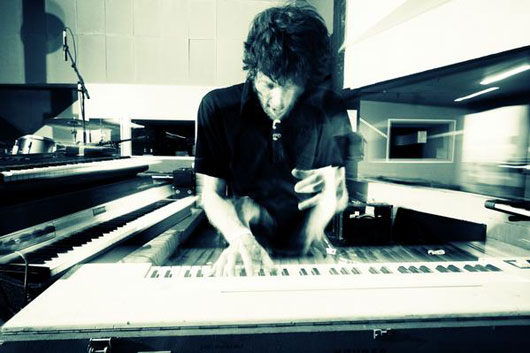Artist Tips: General Elektriks
Since moving to the Bay Area from France in 1999, one-man-band General Elektriks (a.k.a. Hervé […]

Since moving to the Bay Area from France in 1999, one-man-band General Elektriks (a.k.a. Hervé “RV” Salters) has blessed this side of the pond with a particularly quirky style of vintage soul. On his sophomore LP, Good City for Dreamers (Quannum), this keyboardist/producer reaches for a more pop-friendly sound, but doesn’t neglect his favored analog grit. Instead of relying on popular plug-ins, RV often captures the textured grain on his songs with a selection of effects pedals. Here he tells us about the five pedals that helped give his latest album as General Elektriks such character.

DigiTech Whammy
This pedal allows you to bend whatever signal you put through it upward or downward, depending on the setting that you use. I use it very often, sometimes on a keyboard like the Clavinet, so as to get extra expression with the bends (like on the song “You Don’t Listen”) or sometimes as an outboard effect. A good example of the latter would be the intro theme on “Little Lady,” where I tracked an acoustic piano with a microphone into the Digi 002 interface. I then sent that piano part out of the Digi 002 and into the Whammy pedal and an amp, which I then mic-ed and tracked back into the 002. I used the “one octave lower” setting on the Whammy for that part, and it made the piano sound like it was sampled from old ’78 vinyl.

Electro-Harmonix Holy Grail Reverb
This is a killer reverb pedal (and cheap!). I use mostly the “spring reverb” setting, which sounds somewhere between the kind of reverb that you get on a vintage Fender amp and an old plate. It’s all over the album. I used it on the verse vocals on “Raid the Radio.” Since there are multiple vocal layers on those verses, I bounced them onto a mono track, which I then sent into the Holy Grail. I then blended the reverb track with the original dry vocal tracks. I find that the result sounds much closer to an old school plate reverb than most reverb plug-ins.

fOXX Tone Machine
This might be the fattest-sounding fuzz pedal out there. Whatever you put through it ends up sounding giant. It obviously sounds good on a keyboard or guitar, but I’ve also used it on drums or vocals. The heavier-sounding parts on “Engine Kicking In,” for example, feature a drum part that I sent through the fOXX. I also sent the verse lead vocal from “Raid the Radio” into the fOXX, and tucked the fuzz vocal way underneath the dry track so as to create a fatter vocal bed. It’s barely audible, but it adds subtle excitement to the whole part.

Tech 21 SansAmp GT2 Preamp
I hear that the Dust Bothers used this pedal a lot on Beck’s Odelay. It’s a great amp simulator that also works as a very flexible distortion pedal. It’s got many different settings and tones, and it’s hard not to eventually stumble upon a tone that you like. We sent the entire mix of the first song on the album through it, then layered the distorted mix deep underneath the original two-track, thus adding extra life.

Cassette Recorder
Not technically a pedal, but hey. On the song “You Don’t Listen,” I had to replace a sample that would prove too costly to use. I replayed some synths in the spirit of the original sample, but I was missing the analog hiss and static that I had with the vinyl. So I sent my new synths into a cassette recorder, making sure that the signal was nice and hot, thus getting some lovely tape hiss and compression.

